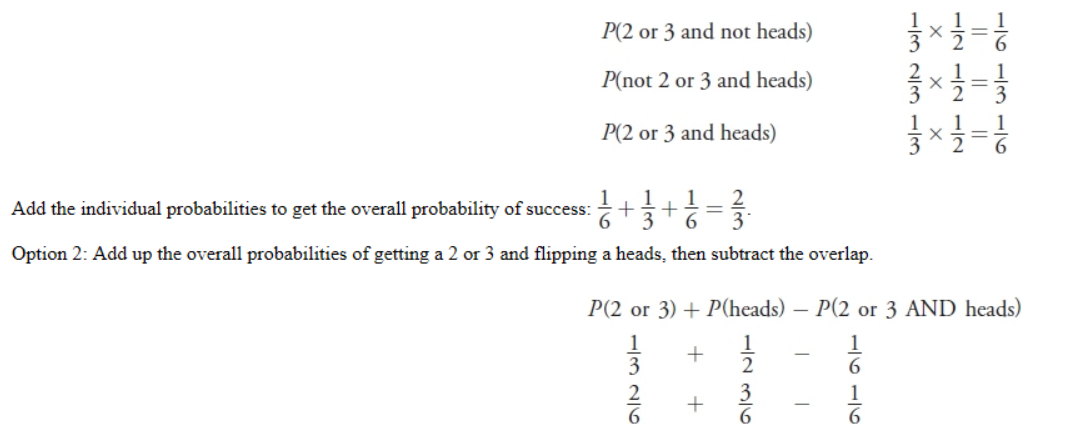Events & Promotions
|
|

GMAT Club Daily Prep
Thank you for using the timer - this advanced tool can estimate your performance and suggest more practice questions. We have subscribed you to Daily Prep Questions via email.
Customized
for You
Track
Your Progress
Practice
Pays
Not interested in getting valuable practice questions and articles delivered to your email? No problem, unsubscribe here.
- Nov 20
07:30 AM PST
-08:30 AM PST
Learn what truly sets the UC Riverside MBA apart and how it helps in your professional growth
Kudos
Bookmarks
Be sure to select an answer first to save it in the Error Log before revealing the correct answer (OA)!
Difficulty:
(N/A)
Question Stats:
33% (01:39) correct 66% (02:41) wrong
66% (02:41) wrong  based on 3 sessions
based on 3 sessions
History
Date
Time
Result
Not Attempted Yet
A fair die, numbered 1 through 6, is rolled, and a fair coin (heads and tails) is flipped. What is the probability that either the die will roll a 2 or 3, or the coin will land heads up, or both?
Kudos
Bookmarks
Sajjad1994
The probability that the die will roll number other than 2 or 3 = 4/6 = 2/3
The probability that the coin will lands tails up = 1/2
T probability of both happening = 2/3 * 1/2 = 1/3
The probability that either the die will roll a 2 or 3, or the coin will land heads up, or both = 1 - 1/3 = 2/3
Kudos
Bookmarks
OE
There are two independent events: the die roll and the coin flip.
Because the outcomes of the events in this question are not mutually exclusive, you have two options to solve. Option 1 is to compute each mutually exclusive event before adding them. Option 2 is to add up the probabilities of the two events as though they were independent, and then subtract the overlap.
To use either option, first calculate the probability that the die will come up 2 or 3. Those are mutually exclusive and each has a probability of 1/6, so the probability that one or the other will occur is 1/6+1/6=1/3. The probability that you will get neither a 2 nor a 3 is therefore .
Next, the probability of flipping heads is and the probability of not getting heads is also 2/3.
Option 1: List out every mutually exclusive successful scenario and calculate its probability.

The answer is \(\frac{4}{6}\), which simplifies to \(\frac{2}{3}\).
If you arrived at an answer of \(\frac{5}{6}\) by adding \(\frac{1}{3}\) and \(\frac{1}{2}\), you were accidentally double-counting. Using this method, when the die lands on a 2 or 3 AND the coin lands on heads, you will have counted that outcome twice. It’s necessary to subtract out one of the two double-counted items.

GMAT-Club-Forum-gnvqdj7w.png [ 129.97 KiB | Viewed 118 times ]
There are two independent events: the die roll and the coin flip.
Because the outcomes of the events in this question are not mutually exclusive, you have two options to solve. Option 1 is to compute each mutually exclusive event before adding them. Option 2 is to add up the probabilities of the two events as though they were independent, and then subtract the overlap.
To use either option, first calculate the probability that the die will come up 2 or 3. Those are mutually exclusive and each has a probability of 1/6, so the probability that one or the other will occur is 1/6+1/6=1/3. The probability that you will get neither a 2 nor a 3 is therefore .
Next, the probability of flipping heads is and the probability of not getting heads is also 2/3.
Option 1: List out every mutually exclusive successful scenario and calculate its probability.
The answer is \(\frac{4}{6}\), which simplifies to \(\frac{2}{3}\).
If you arrived at an answer of \(\frac{5}{6}\) by adding \(\frac{1}{3}\) and \(\frac{1}{2}\), you were accidentally double-counting. Using this method, when the die lands on a 2 or 3 AND the coin lands on heads, you will have counted that outcome twice. It’s necessary to subtract out one of the two double-counted items.
Attachment:
GMAT-Club-Forum-gnvqdj7w.png [ 129.97 KiB | Viewed 118 times ]








